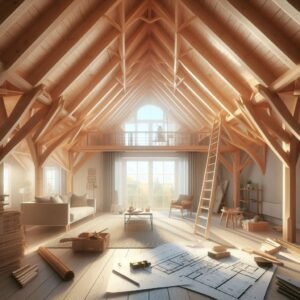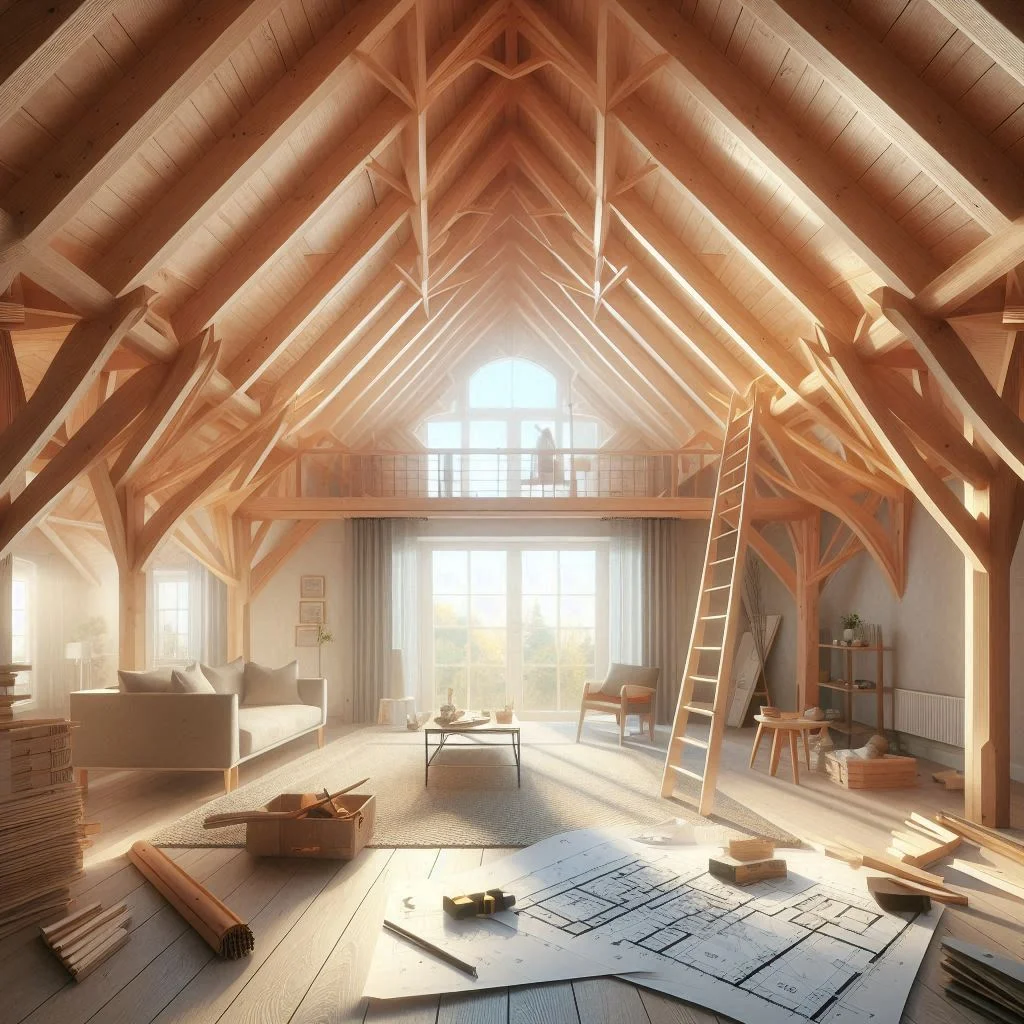Your home is a reflection of your personal style and preferences. Sometimes, the existing architectural features of a house can feel limiting, especially when it comes to the ceiling. If you’ve ever wished for more space and a modern, open feel in your home, converting a hip roof to a vaulted ceiling might be the solution you’ve been looking for. In this blog post, we will explore the process, benefits, and considerations of this transformative home improvement project.
Understanding Hip Roofs
Before diving into the conversion process, it’s essential to understand what a hip roof is. A hip roof is characterized by its sloping sides that meet at the top to form a ridge. While hip roofs are known for their stability and durability, they can create a closed-in feeling, making rooms seem smaller and less open.
Why Choose a Vaulted Ceiling?
Vaulted ceilings, on the other hand, offer a spacious and open ambiance to any room. Here are some compelling reasons to consider converting your hip roof into a vaulted ceiling:
1.Enhanced Aesthetics: Vaulted ceilings are visually stunning and can transform the look and feel of your home. They create an illusion of more space and provide a sense of grandeur.
2.Increased Natural Light: Vaulted ceilings allow for larger windows and skylights, letting in more natural light. This not only brightens up your living spaces but also reduces the need for artificial lighting during the day, saving on energy costs.
3.Improved Ventilation: The increased height of vaulted ceilings promotes better air circulation, keeping your home cooler in the summer and reducing the need for excessive air conditioning.
4.Greater Design Flexibility: With a vaulted ceiling, you have more design possibilities. You can incorporate unique architectural elements, such as exposed beams or a dramatic focal point, to make your home truly one-of-a-kind.
The Conversion Process
Converting a hip roof to a vaulted ceiling is a significant undertaking that requires careful planning and execution. Here’s an overview of the process:
1.Assessment: Begin by assessing the structural integrity of your home and the feasibility of the conversion. Consult with a structural engineer or architect to ensure your home can support the changes.
2.Permits and Regulations: Check local building codes and obtain the necessary permits for the project. Compliance with building regulations is essential to ensure safety and legality.
3.Roof Removal: The existing hip roof will need to be removed carefully, section by section, to avoid damage to the rest of the structure.
4.Reframing: This step involves creating the new vaulted ceiling structure. It may include installing new trusses, beams, and supports to maintain the structural integrity of your home.
5.Insulation and Wiring: Proper insulation is crucial for energy efficiency. Additionally, you may need to reroute electrical wiring and install new lighting fixtures.
6.Drywall and Finishing: Once the structural changes are complete, drywall is installed, and the finishing touches are added, including paint and trim.
7.Decor and Furnishing: With your new vaulted ceiling in place, you can redecorate and furnish the space to suit your preferences and style.
Considerations and Challenges
While converting a hip roof to a vaulted ceiling offers numerous benefits, it’s important to be aware of potential challenges and considerations:
1.Cost: This project can be expensive due to the structural changes required. Obtain multiple quotes from contractors to ensure it fits within your budget.
2.Timeframe: Converting a roof takes time, and your home may be temporarily uninhabitable during certain phases of the project. Plan accordingly.
3.Professional Help: This is not a DIY project. Hiring experienced contractors and professionals is essential to ensure the safety and success of the conversion.
4.Resale Value: Consider whether the investment in a vaulted ceiling aligns with the potential resale value of your home and your long-term plans.
Considerations for Your Vaulted Ceiling Conversion:
1.Materials: When planning your vaulted ceiling conversion, think about the materials you want to use. Exposed wooden beams can create a warm and rustic look, while sleek drywall finishes provide a modern touch. Your choice of materials will greatly influence the overall aesthetics of the space.
2.Height: The height of your vaulted ceiling is a critical factor in the design. A higher ceiling can make a room feel even more spacious and grand, but it may also affect heating and cooling costs. Finding the right balance is essential.
3.Lighting: Take advantage of the increased vertical space by incorporating creative lighting solutions. Pendant lights, chandeliers, and recessed lighting can all enhance the ambiance of the room. Consider how lighting fixtures will complement your design.
4.Color Palette: The colors you choose for your vaulted ceiling and walls can significantly impact the perception of space. Lighter colors tend to make a room feel more open and airy, while darker shades can create a cozy and intimate atmosphere.
5.Furniture Placement: With the higher ceiling, you have more flexibility in arranging your furniture. Consider creating zones within the room to define different areas of use. This can be particularly useful in open-concept living spaces.
Design Ideas for Vaulted Ceilings:
Exposed Beams: Exposed wooden beams can add character and warmth to your vaulted ceiling. They can be stained or painted to match your desired aesthetic. Beams also provide structural support, giving a rustic charm to the space.
Skylights and Windows: If possible, incorporate skylights or large windows into your vaulted ceiling design. This not only brings in natural light but also provides a stunning view of the sky or surrounding scenery.
Focal Points: Consider creating a focal point in the room, such as a dramatic fireplace, a striking piece of artwork, or a unique architectural feature. A vaulted ceiling provides the perfect canvas for such elements.
A Frame Ceilings: In some cases, A-frame ceilings, which are characterized by sloping sides that meet at a central beam, can be a captivating choice. This design adds an element of drama and uniqueness to your space.
Incorporate Decor: Use decor elements like tall bookshelves, large mirrors, or vertical artwork to emphasize the height of the vaulted ceiling. These can draw the eye upward, making the room feel even more spacious.
Maintenance and Long-Term Considerations:
Maintaining a vaulted ceiling, especially one with exposed beams or unique features, may require additional care compared to a standard flat ceiling. Regular dusting, occasional beam inspections, and potential resealing or refinishing of materials should be factored into your long-term home maintenance plan.
In conclusion, converting a hip roof to a vaulted ceiling can be a transformative project that breathes new life into your home. It offers not only aesthetic benefits but also improved functionality and comfort. Whether you’re looking to create a cozy retreat or a modern, open living space, carefully planning and executing this conversion can help you achieve the home of your dreams. Just remember to work with professionals, adhere to local regulations, and let your creativity guide you in making the most of your vaulted ceiling.


